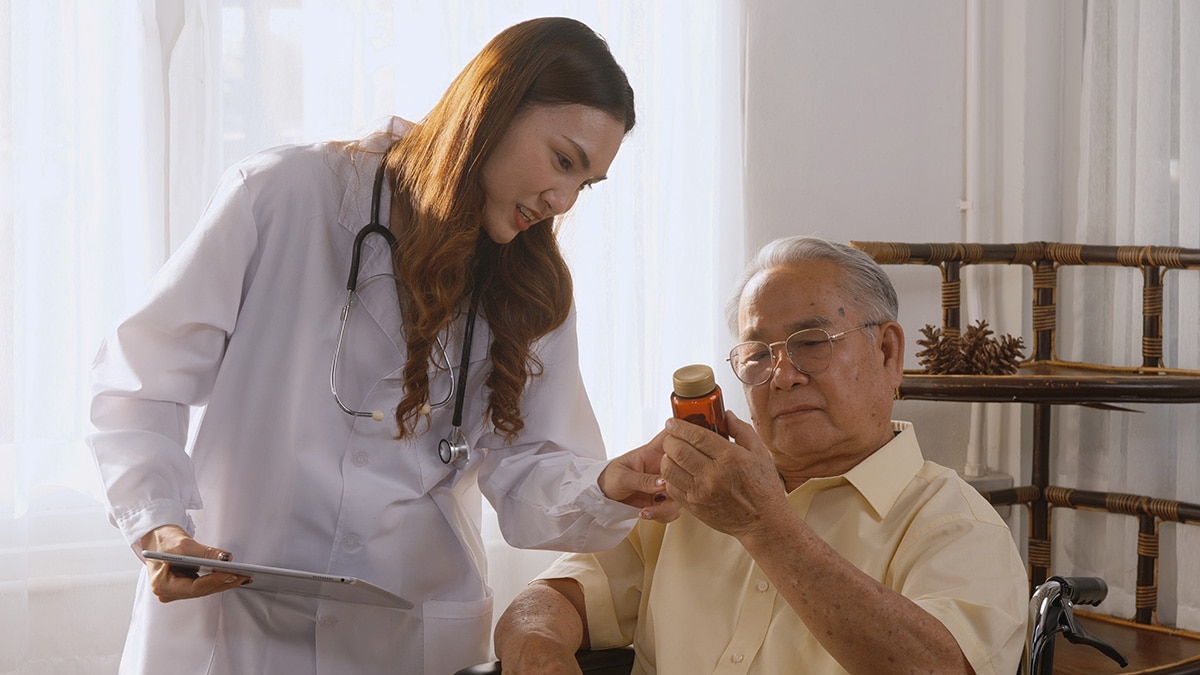Treatments for Bladder Control Problems (Urinary Incontinence)
Can I treat my bladder control problem myself?
Depending on the type of urinary incontinence (UI) you have, your health care professional may recommend steps you can take on your own to try to control your symptoms.
Make lifestyle changes
You may be able to reduce leaks by making lifestyle changes.
Drink the right amount of liquid at the right time
Ask your health care professional whether you should drink less liquid during the day. However, don’t limit liquids to the point of becoming dehydrated. Your health care professional can tell you how much and when to drink, based on your health, activities, and local climate.
To limit nighttime trips to the bathroom, you may want to stop drinking liquids a few hours before bedtime, but only if your health care professional suggests it. Limiting foods and drinks with caffeine, such as chocolate, tea, coffee, and carbonated beverages, may help reduce leaks. You should also limit alcoholic drinks, which can increase how much urine your body makes.
The amount of urine a person should make is different for everyone, based on how much liquid you drink, how much you sweat, how much liquid you lose by breathing, and the medicines you take.
Be physically active
Although you may not feel like being physically active when you have UI, regular physical activity is important for weight management and good overall health. Activities such as walking, swimming, biking, and dancing can improve your health. If you’re concerned about not having a bathroom nearby during physical activity, find a place with nearby restrooms, such as a shopping mall, community park, or local gym.

Keep a healthy weight
Your chances of developing UI and other diseases, such as diabetes, are higher if you’re overweight or have obesity. Losing weight can help you have fewer leaks, and avoiding weight gain may prevent UI. Studies suggest that as your body mass index (BMI) increases, you’re more likely to leak.4 If you’re overweight or have obesity, talk with your health care professional about how to lose weight.
Avoid constipation
Constipation can make urinary tract health worse and can lead to UI. Talk with your health care professional about drinking more liquids and eating enough fiber to avoid constipation. Health care professionals use medicines called anticholinergics, tricyclic antidepressants, and beta-3 agonists to treat UI, but they can cause constipation.
Stop smoking
If you smoke, get help to stop smoking. Quitting smoking at any age is good for your bladder health and overall health. Smoking raises your chances of developing stress incontinence, because smoking causes chronic, or long-lasting, coughing. You might improve your UI if you’re able to stop coughing.5
Smoking also causes most cases of bladder cancer. Some people say smoking irritates their bladder.
Train your bladder
Bladder training is when you urinate on a schedule to reduce leaking. Your health care professional may use your bladder diary (PDF, 487.59 KB) to suggest you use the bathroom on a regular schedule, called timed voiding. Gradually lengthening the time between trips to the bathroom can help stretch your bladder so it can hold more urine. Record your daily bathroom habits so you and your health care professional can review your diary.
Do pelvic floor muscle exercises
Strong pelvic floor muscles hold in urine better than weak muscles. You can strengthen your pelvic floor muscles by doing Kegel exercises. These exercises involve tightening and relaxing the muscles that control urine flow. Researchers found that women who received pelvic floor muscle training had fewer leaks per day than women who didn’t receive training.6 You should not do pelvic floor exercises while you’re urinating.
Men can also benefit from pelvic floor muscle exercises. Strengthening these muscles may help a man leak urine less often, especially dribbling after urination.
A health care professional, such as a physical therapist trained in pelvic floor therapy, can help you get the most out of your Kegel exercises by helping you improve your core muscle strength. Your core includes your torso muscles, especially the lower back, pelvic floor muscles, and abdomen. These muscles keep your pelvis lined up with your spine, which helps with good posture and balance. Your physical therapist can show you how to do some exercises during daily activities, such as riding in a car or sitting at a desk.
You don’t need special equipment for Kegel exercises. However, if you are unsure whether you are doing the exercises correctly, you can learn how to perform Kegel exercises properly by using biofeedback, electrical stimulation, or both. Biofeedback uses special sensors to measure muscle contractions that control urination.
Control your urge to urinate
You may be able to control, or suppress, the strong urge to urinate, which is called urge or urgency suppression. With this type of bladder training, you can worry less about finding a bathroom in a hurry. Some people distract themselves to take their minds off needing to urinate. Other people find that long, relaxing breaths or holding still can help. Doing pelvic floor exercises to strengthen your pelvic floor also can help control the urge to urinate. Quick, strong squeezes of the pelvic floor muscles can help suppress urgency when it occurs, which may help you get to the toilet before you leak.
How can my health care professional treat my bladder control problem?

If lifestyle changes aren’t working for you, your health care professional may prescribe medicine, a medical device, a bulking agent, or—as a last resort—surgery to help treat UI.
Medicines
Urgency incontinence may be treated with one of the following medicines as a pill, liquid, or patch to relax your bladder
- anticholinergics
- beta-3 agonists
- tricyclic antidepressants
Health care professionals may use botulinum toxin A, also known as Botox, to treat UI when other medicines or self-care treatments don’t work. Botox may be injected into your bladder. Injecting Botox into the bladder relaxes it, which makes more room for urine and lowers the chances of urine leaks.
In addition to anticholinergics, men with UI who have an enlarged prostate may also be prescribed
Medical devices
Catheter
Individuals with overflow incontinence may need to use a catheter to empty their bladder. Your health care professional will teach you how to use a catheter. Proper hygiene is important for catheter use and to avoid a bladder infection.
Pessary
Women may use a soft, plastic device called a pessary, which is inserted into the vagina for stress incontinence. The pessary presses against the wall of your vagina and the nearby urethra. The pressure helps hold up the urethra, so you have less leaking.
Another newer product to treat stress incontinence is a tampon-like disposable device that you can insert into your vagina for up to 12 hours at a time. The product expands to push up against your urethra to help decrease leaks.
Bulking agents
Gel or paste can be injected near your urinary sphincter to treat stress incontinence. The injected material bulks up the area around the urethra. The extra thickness helps close your bladder opening so you leak less.
Electrical nerve stimulation
If medicines and lifestyle changes don’t help your UI, your health care professional may suggest electrical nerve stimulation for urgency incontinence and other symptoms. Electrical nerve stimulation changes your bladder’s reflexes, using mild pulses of electricity to stimulate the nerves that control the bladder and sphincter muscles.
Surgery
Sling surgery
The most common surgery to treat stress incontinence in women is sling surgery. In sling surgery for women, a surgeon works through the vagina to insert a strip of material between the vagina and urethra. The surgeon may choose to use a synthetic mesh, a screen-like material that supports weakened or damaged tissue, or the surgeon may choose a biologic graft made from human or animal tissue.
Although sling surgery with synthetic mesh can be successful and safe, complications can occur in some women. Your health care professional can explain the risks and benefits of surgery for stress incontinence and what kind of results you can expect.
Stress incontinence in men can be treated with the male sling—a procedure in which mesh is placed under the urethra, lifting and supporting the urethra and sphincter muscles.
Artificial urinary sphincter
Stress incontinence in men can be treated by implanting an artificial urinary sphincter—a device that helps keep the urethra closed to prevent leaks.
Surgery to remove a blockage
Overflow incontinence caused by a blockage or a narrowed urethra can be treated with surgery to remove the blockage.
Bladder outlet obstruction may occur in men who have an enlarged prostate. When other treatments don’t work well enough, your health care professional may suggest surgery, including minimally invasive surgery, to remove enlarged prostate tissue or to widen the urethra.
Bladder enlargement, or bladder augmentation
If UI is caused by nerve damage, your health care professional may suggest surgery to make your bladder larger. This procedure may allow your bladder to store more urine but can make the bladder more difficult to empty, which may require you to use a catheter to empty your bladder.
 Try lifestyle changes to treat your bladder problem. If that doesn’t work, your health care professional may prescribe medicine, a medical device, or a bulking agent.
Try lifestyle changes to treat your bladder problem. If that doesn’t work, your health care professional may prescribe medicine, a medical device, or a bulking agent.
How can I cope with bladder control problems?
Protective products
Even after treatment, you may still leak urine from time to time. Certain products can help you cope with urine leaks
- Absorbent, washable incontinence underwear. You can use underwear lined with special fabric that absorbs urine.
- Waterproof underwear. Waterproof underwear can protect your clothes from getting wet.
- Adult incontinence briefs. You can wear disposable incontinence briefs that act like diapers to keep your clothes dry.
- Pads. You can wear disposable pads in your underwear to absorb leaking urine.
- Large disposable pads. You can use large pads to protect chairs and beds from urine.
- Special skin cleaners and creams. Special skin cleaners and creams may keep the skin around the urethra from getting irritated. Creams can help block urine from your skin.
- Urine deodorizing tablets. Talk with your health care professional about whether taking urine deodorizing tablets by mouth can make your urine smell less strong.
- External catheters. An external catheter, used by men, can collect urine from a man’s body and drain it into a bag that is attached to the thigh with a strap.
Emotional support
Bladder control problems are common, yet many people feel too embarrassed to talk about them. At the very least, talk with your health care professional about your bladder problems. Your health care professional can help you connect with a support group for people with similar problems.
Consider speaking with your family and friends about your UI. Your family and friends may make it easier for you to manage UI. In sharing your struggle, you may find that other people in your life have bladder problems as well.
References
This content is provided as a service of the National Institute of Diabetes and Digestive and Kidney Diseases
(NIDDK), part of the National Institutes of Health. NIDDK translates and disseminates research findings to increase knowledge and understanding about health and disease among patients, health professionals, and the public. Content produced by NIDDK is carefully reviewed by NIDDK scientists and other experts.

